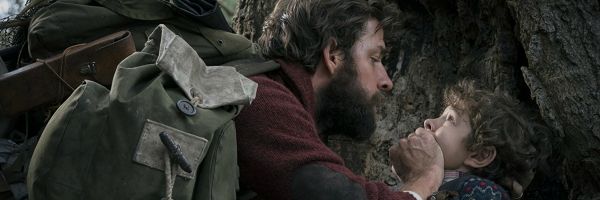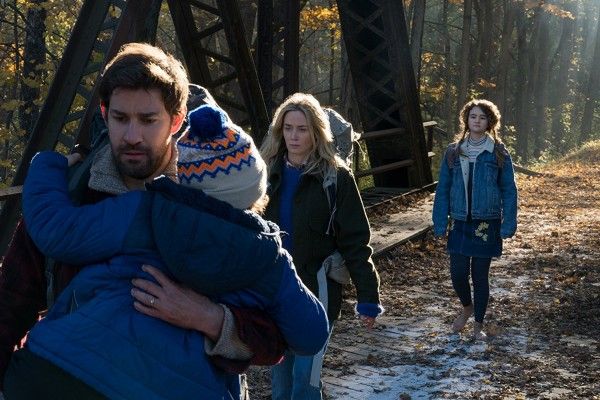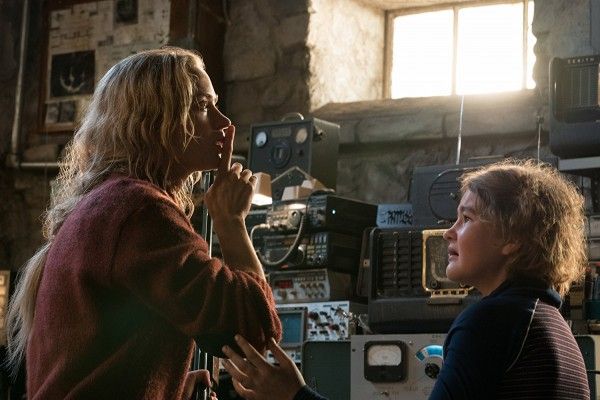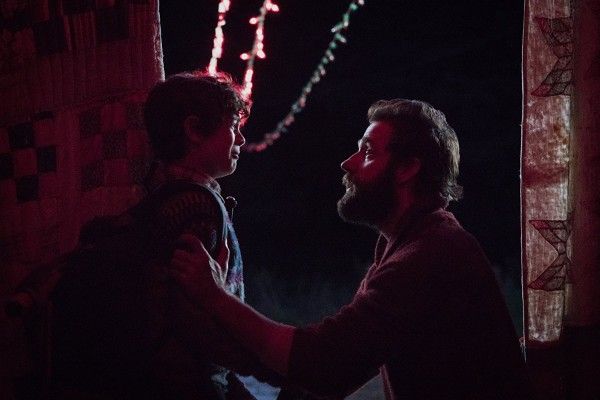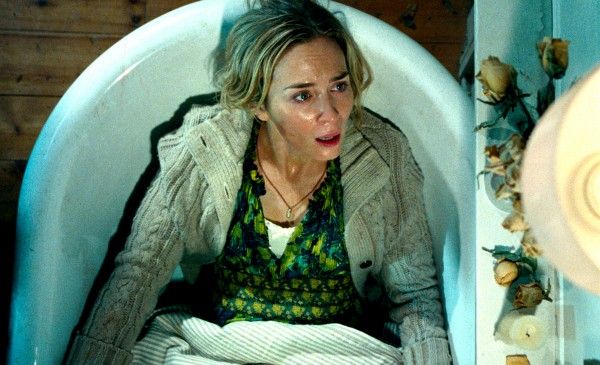Indestructible insectoid creatures prowl the earth. They hunt by sound and they're not only impeccably efficient in hunting their prey, they're deadly fast. Don't scream. Don't drop anything. Don't even whisper too loud, or they'll find you and that's that. You’re dead.
The concept is pure and perfectly suited to the genre, and it's a brilliant conceit because it makes you a part of the experience. When you watch A Quiet Place, you’ll sit glued to your seat in a theater so quiet you can hear a pin drop. That’s as great a testament as any to what John Krasinski accomplishes in his third directorial effort (his first time working in horror). A filmmaker with lesser command would lose the audience in the prolonged moments of silence, inviting snickers and whispers among the crowd, but this movie grips you with performance and atmosphere and never once loses its hold. You’re a participant, you’re in it, and you won’t want to make a sound.
A Quiet Place transports you to this survivalist horrorscape with the most unlikely, relatable of survivors — a loving nuclear family just trying to make it through. Mother, Evelyn (Emily Blunt), Father, Lee (Krasinski), and their young children (Noah Jupe, Millicent Simmonds, and Cade Woodward). The film opens with a title card that reads “Day 89,” where we meet the Abbott family; pillaging the remains of the drugstore ever so carefully so as not to disturb any pill bottles, communicating in sign language, and teaching the children the life or death ways of silence, no matter what.
Working from a script he co-wrote with Bryan Woods and Scott Beck, Krasinski has the nerve and good taste to drop you straight into the nightmare; no lengthy exposition, no government agents explaining how society collapsed, just a few well-placed newspaper clippings and enough context cues to ensure you know exactly as much as you need to. The streets are deserted, missing posters lining the walls of abandoned buildings, and everyone we see trembles at the thought of making a sound. The world went to hell. We’re all familiar with the cinematic language of apocalypse by now, and Krasinski gives his audience enough credit not to spell everything out for them. That wise instinct, combined with the fact that the characters literally cannot talk, ensures that A Quiet Place’s wiry 90 minutes are spent immersed in action instead of talky diversions.
After a brief prologue that roots the film in grief and guilt, we jump to a year later, and hello worst nightmare, mom’s pregnant again. The mind practically summersaults into all the horrific possibilities -- is silent home birth even possible, and how do you keep a baby from crying once its born? The family tries their best to prepare for the unthinkable, readying themselves for the due date with clever contraptions and systems of silent communication. Krasinski builds their world in rich detail, telegraphing the logistics of the family’s survival through action, and he takes equal care in building out the tense but loving dynamic between the family.
When he’s not prepping for the baby or hunting their dinner, Lee is ever-tinkering with new tech, trying to create a cochlear implant for his hearing impaired daughter (Simmonds) that actually works. They never do, but he never stops trying no matter how frustrated his daughter gets, and you can imagine how frustrated she gets wandering around in a world where the ability to hear is tantamount to the ability to live. In a particularly smart touch from Krasinski and his sound team, the silence changes overtime we shift to her perspective, a soft buzz humming over total silence.
You learn to love this family quickly, and it only takes a few tender moments to totally win your heart. In particular, a silent slow dance sticks with you through the chaos. Each performer is fantastic in this film, but Blunt in particular is extraordinary, proving she would have been just as remarkable a film star in the silent era as she is now.. This family is smart and resilient, but they’re also human, which means they’re fallible. Their carefully crafted web of survival is only tenable until some incident or accident makes silence impossible. A Quiet Place is filled with incidents and accidents, and once Kraskinski pulls the rug from under his characters, he never gives them a moment’s rest in an utterly breathless two-act cavalcade of creature feature action.
Comedy and Horror exist as opposite sides of the same cinematic coin. Both inspire instant, involuntary physical responses in the audiences. The knee-jerk sides of cinema, they have the power to quite literally make audiences bend to their will — be it a gasp, a laugh, or a jump. Krasinski employs his refined comedian’s timing here with masterful effect, stringing together a number of expert set-pieces. Krasinski takes more than a couple cues from Spielberg — there’s a whole lot of Jurassic Park’s DNA in this movie, but most obviously, Krasinski takes Jaws approach, building fear of his monsters by keeping them off-screen.
Krasinski makes a commanding, ferocious debut in the genre, but that's not to say the film is without its faults. The fundamental premise insists it has to become a jump scare movie —and jump scares, never the most satisfying type of theatrical thrill, can be a grinding, frustrating experience with too much repetition. Krasinski doesn’t overdo it often, but the film’s present silence ensures A Quiet Place has more than such a clever film needs every time there’s a loud noise — and boy are the noises loud. The first few shocks that pierce the quiet are jarring and explosive, as they should be, and the theater practically quaked out of their seats with the impact, but there are indulgent moments as the film’s runtime wears on that feel cheaper and derivative.
Then there’s the matter of the creatures themselves. They’re brilliant in concept and clever in design, and despite the fact that ILM does reliably excellent work on the effects, there’s the sense that the film would have benefited from the inclusion of more practical elements. The setting is rich with tactile details that keep you rooted in the moment — swaying cornfields, bright red lights, running water — and the digital creatures always feel somewhat out of place. The human eye is too good at sussing out artificiality, especially when it’s surrounded by nature.
Fortunately, these faults don't undermine the picture because Krasinski doesn’t rely on the jump scares, he doesn't even rely on the monsters that much. Instead, he roots everything in the constant, oppressive anxiety of parenting — the primal, universal terror and impulse to protect your family. Krasinski sets the stage by reminding us how little control we have over the things we love, and he never lets up, tying every piece of the drama and the tension into seemingly impossible survival of this family unit. How do you protect your children? How do you best love them and teach them? How do you ensure they’ll be OK when you’re gone? All these shared fears and ancient anxieties are the deep well from which Krasinski spins his thrilling, surprisingly sweet survivalist yarn, giving A Quiet Place an elegant simplicity that plays with the focus of a feature-length Twilight Zone episode, every moment and character beat tied back to the central theme
Rating: B+

